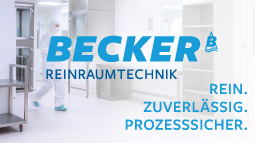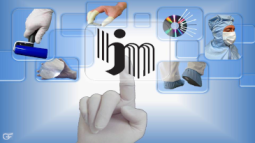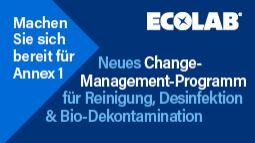Shrinking lot sizes and enormous volumes of data create opportunities for the pharmaceutical industry
Small lot sizes, reliable containment. The fact that these things are on the pharmaceutical industry's wish list is nothing new, but the growth of personalized medicine and high-potency drugs increases the sense of urgency. A number of exhibitors in "pharmaceutical and packaging Halls" 1 and 3 at ACHEMA have taken aim at these needs and offer efficient solutions which support the trend towards personalized medicine. Some companies are also positioning themselves as Industry 4.0 pioneers in areas such as services and software or simply by beginning to add an IT integration dimension to systems engineering and machinery manufacturing.
Growth in the pharmaceutical market remains modest. BPI reported that turnover worldwide was up 3.6% year-on-year in 2016. Growth rates were as high as 10% during the 1990's, but those days are gone for most pharmaceutical companies. Dieter Weinand, head of pharmaceuticals at Bayer, gave the keynote speech at the Handelsblatt pharmaceutical conference in Berlin in February 2018. During his talk, he stressed the need for the industry to "take a critical look at its business models and embrace new paradigms". Competition, often in the form of generics and biosimilars, continues to intensify, and the inevitable consequence is greater price pressure. More and more, yesterday's patent-protected blockbusters are being replaced by medication for individualized therapy.
These trends have an impact on the systems and machinery needed for production. More individualized medication, particularly for serious disease such as cancer, often goes hand in hand with biotechnologically produced, high-potency drugs and a very demanding requirements profile for the filling and packaging solutions. Increasing cost pressure, which is the second trend, primarily affects medication for the mass market. The response to this problem is solutions which make production more cost efficient. For years, packaging system manufacturers have taken the proven approach of increasing the level of automation and reducing manual intervention by the user. Another option, which has not been fully exploited by many users, is to significantly increase availability, ideally by enhancing overall equipment effectiveness (OEE). Among other things, that means less maintenance. When such work is necessary, then ideally with the aid of innovative, predictive maintenance strategies. In the future, the power of digitalization will help make production more efficient over the life cycle by reducing energy consumption or providing capabilities such as predictive maintenance and self-adaptation in response to process deviations without intervention by the operators.
Of course answers also have to be found for existing challenges. Counterfeit protection, serialization and traceability are still significant challenges for pharmaceutical product packaging. "Local and international laws are a major factor in serialization," reported Davide Brancaleoni, Packaging Segment Leader EMEA at Rockwell Automation. There is market demand for both integrated and open serialization solutions. On top of that, personalized medicine creates new challenges. "Each and every product must be filled and packaged correctly and associated with the correct data record which contains the batch and production history."
Living cells in mini batches
Personalized medicine does not necessarily mean lot sizes of one. However, "the same treatment plan fits all" approach will play a less important role in the years ahead. Small to very small lot sizes for specific doses of a particular medication are already a necessity for some types of treatment in combination with state-of-the-art diagnostics including gene diagnostics. Stratified medicine, where for example tumor patients are divided into subgroups which respond, or do not respond, to a specific active ingredient is also part of the picture. This leads to therapy targeted at individual patients who are given the best medication in what for them is the most effective dose. The medication is often based on living cells. That naturally places stringent demands on the filling operation. The most suitable type of packaging such as vials or syringes made of plastic or glass, which does not cause problems during storage (possibly in liquid nitrogen), handling and administration, must be selected. In most cases, large shear forces must be avoided during filling of ATMPs (Advanced Therapy Medicinal Products) which are used in new forms of therapy.
All of the processes needed for that are currently available, claimed Dirk Bauernfeind, Product Manager at the Romaco Group: "We can already deliver the format flexibility and special packaging sizes which the industry needs. For one of our reference customers in Northern Ireland, we have developed an innovative packaging solution for orphan drugs." He explained that the packaging has a special feature, namely the inclusion of a desiccant in the individual blister cavities. For many pharmaceutical manufacturers, flexible filling and packaging solutions such as the Bosch MHD for aseptic filling of biopharmaceuticals are the preferred choice. With the aid of robotics, different types of packaging can be filled in the isolator. In response to the trend towards smaller and smaller batch sizes, Romaco offers a mid-range line for primary, secondary and tertiary packaging of pharmaceutical solids. "The line is highly flexible, and it is also very rugged and compact," reported Bauernfeind. He argues that the increased expectations for track & trace create the need for packaging designs which offer the same capacity but take up less space.
Gerhard Breu, who is head of the pharmaceutical business at Optima, said that the company will use robotics technology to meet the need for greater flexibility. It is his expectation that "life cycles will become much more dynamic and that new production variants and containers will be frequently added to the portfolios. In response, he intends to market systems with exceptional format flexibility to handle very small lot sizes. Optima will present a suitable solution at ACHEMA featuring multi-use design for variable filling of vials, syringes and cartridges. The system is based on an adjustable transport system which eliminates the need for format sets. Manufacturers of high-cost active ingredients such as ATMPs will undoubtedly welcome solutions which reduce product wastage, for example by using short tubing, 100% process control and post-dosing on demand.
Andreas Häußner, Marketing Director at the Rommelag Group, is also fully focused on the need to offer customers high flexibility and process reliability. ACHEMA visitors who are looking for flexible packaging solutions capable of producing very low quantities and very small batch sizes at an affordable cost and with built-in traceability should stop by the Rommelag booth. Häußner mentioned a "disposable filling system which we have already used in initial trials aimed at personalized medicine".
Bauernfeind pointed out that the importance of Industry 4.0 differs worldwide. In industrialized countries with high labor costs, Industry 4.0 will soon be very tangible, whereas in emerging markets it is something that is more likely to be relevant in the medium to long term. "Suppliers of packaging machines must be prepared for different scenarios," said Bauernfeind and he added: "There is no other way for us to offer solutions which meet actual needs."
Single-use containment minimizes validation costs
Containment systems and fill & finish are inextricably linked. They protect the operator from high-potency products and vice versa. Single use strategies are also a very effective way of preventing cross-contamination. Pilot solutions which combine containment and single-use design were on display at ACHEMA 2015. In 2018, additional suppliers will exhibit systems which have reached an advanced development stage. However Bauernfeind advised caution: "What is needed is close cooperation with pharmaceutical manufacturers to ensure that the systems are tailored to customer needs without costly over-engineering". He cites continuous manufacturing as a way of protecting machine operators from high-potency substances.
Pharmaceutical machinery manufacturers should also provide risk analysis advice to customers.
Rommelag's Flecotec system is a bit out of the ordinary. All sampling, weighing, filling and decanting processes can continue as normal. They are literally wrapped up with the aid of a single-use containment system. The entire system is then disposed of. "Our solution is to intelligently package the existing process, so there is no need for re-validation," explained Häußner.
Bosch takes a different approach, namely washable containment. It is used in a capsule filler for small batches. Product changeover can be done quickly. The manufacturer promises short cleaning times and low water consumption. The machine makes it easy to handle high-potency solid dosage forms. Some market researchers predict double-digit annual growth for HPAPIs (High Potency Active Pharmaceutical Ingredients) over the next five years. For this market segment, Fette Compacting offers reliable containment solutions and Containment Guard, a quality certificate based on a test process which complies with SMEPAC (Standardized Measurement for Equipment Particulate Airborne Concentrations) guidelines. It documents the OEB level of the containment tableting systems and makes set up easier for customers. They can select the right containment system with greater confidence and reduce the risk of installing a solution which is inadequate or too expensive.
There is also room for innovation in standard isolator technology. Metall+Plastic, which is part of the Optima Group, will exhibit a sterility testing isolator (STISO) which was unveiled for the first time at Interphex in the middle of April 2018. The Stiso is very user-friendly, and the decontamination process has very short cycle times. This is achieved through catalytic air circulation and a special decontamination system which distributes hydrogen peroxide very quickly in droplets that are much smaller than on conventional nebulization systems.
Individual services and Industry 4.0
Gerhard Breu from Optima emphasized that customer-specific solutions are the be-all and end-all for the pharmaceutical sector. Last year, the Group presented an end-to-end strate-gy for services in each phase of the lifecycle, and the strategy is equally suitable for the pharmaceutical business. Factory Acceptance Tests with simulation and start-up support, re-qualification following upgrades, calibration services and comprehensive maintenance services are just some examples from the Total Care portfolio. Optima's goal is very similar to what Bosch intends to deliver with its after-sales services. "Throughout the entire machine lifecycle, we help our customers improve overall equipment effectiveness (OEE) and reduce downtime," reported Uwe Harbauer, head of pharmaceutical products at Bosch.
This goes hand in hand with a high degree of transparency in production, which is one of the features which Bosch plans to deliver with its Industry 4.0 solutions. In the future, live information services will supply all of the data which customers need to monitor machine states and process parameters. Browser-based software captures, stores and visualizes machine data and helps analyze the information to improve system availability.
Davide Brancaleoni, a packaging expert at Rockwell, reiterated that the basic framework must be in place which enables access to all of the pertinent data: "It is vitally important for companies to build up convergent IT infrastructures which support system connectivity and data transfer." Many automation system suppliers can now meet this need, ideally with industry-specific solutions. Rockwell Automation, for example, offers modules from its FactoryTalk portfolio such as Pharmasuite MES and Factory Talk Historian to log data and highlight trends and changes. Brancaleoni argues that correct use of the data forms the backbone of track & trace solutions. "In that respect, Industry 4.0 plays a vital role in phar-maceutical production." Rockwell solutions create the link between production technology and the IT and enterprise systems.
Suppliers of filling and packaging systems must also show that they have the necessary expertise in data networking, data integrity and cyber security. This is especially the case with filling and packaging lines for large pharmaceutical corporations. To an increasing extent, the systems must be integrated into the overall corporate IT ecosystem, for example MES and Historian systems. Integration solutions with real potential which pave the way to big data, data analytics and Industry 4.0 already exist, and there are even some initial projects. Breu from Optima remains vague, but he is convinced of one thing: "None of this will happen without integrated digitalization. Digitalization will be indispensable for managing the production process of the future." Suppliers of pharmaceutical filling and packaging systems will not be able to put any solutions on display at this year's ACHEMA. However pharmaceutical manufacturers who are willing to embrace new paradigms and align their business models with Industry 4.0 should not hesitate to make inquiries.
DECHEMA Ausstellungs-GmbH
60486 Frankfurt am Main
Germany








